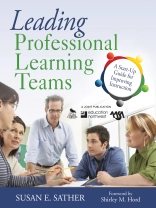‘As a high school principal, it is crucial to have tools and models that have teeth, that will make an impact on student achievement, and also improve collegiality and collaboration among teachers. This is a wonderful faculty book study choice for any school looking to have teams of teachers focused on data and how to incorporate best practices in their classrooms.’
—Steve Knobl, Principal
Gulf High School, New Port Richey, FL
Strengthen teacher expertise and expand instructional leadership through focused professional learning teams!
Although a generous amount of research describes professional learning teams (PLTs) as a positive structure for developing a vision of school change through informed, data-based decision making, little guidance exists for schools wanting to create and sustain this type of team initiative.
Leading Professional Learning Teams provides a field-tested model for implementing PLTs that strengthen teacher collaboration in professional learning communities, improve instruction, and increase student achievement. Developed in partnership between educators, Education Northwest (formerly known as the Northwest Regional Educational Laboratory), and six high-needs schools, this guide shows a professional learning team in action. Each chapter highlights four important elements to help ensure alignment with educators′ objectives:
- Action: Steps for starting up a PLT
- Voices From the Field: School leaders offering insights from actual PLTs
- Tools: Resources with information about PLTs, plus at-a-glance road maps for each step of the implementation process
- Leadership Team Discussion: Discussion suggestions for implementation leaders
Written for school leaders who are new to PLTs and those who want to fine-tune their efforts, this resource is an invaluable tool for correlating staff development with your school′s improvement goals.
Содержание
List of Figures and Tables
Foreword by Shirley M. Hord
Preface
Acknowledgments
About the Author
1. Understanding Professional Learning Teams
Defining Professional Learning Teams
The Need for PLTs
Other Models for Teacher Collaboration
Key Points for Chapter 1
2. Setting the Stage for Success
Readiness for PLTs
Understanding Change
Building Relationships
Creating Avenues of Communication
Key Points for Chapter 2
3. Laying the Foundation Within the School Community
Advocating for PLTs With Important Stakeholders
Aligning With School Goals
Structures for Working Collaboratively
Providing and Using Data
Providing Additional Resources
Establishing Supportive Accountability
Key Points for Chapter 3
4. What About Leadership?
Administrators as Leaders
Shared and Facilitative Leadership
Teacher Leadership
Sustaining Leadership
Vignette: A Professional Learning Team in Action
Key Points for Chapter 4
5. Supporting the Work of PLTs
Successful PLTs
Reinforcing PLT Strategies and Skills
Ensuring That PLTs Are Teacher Led
Using a Rubric to Encourage Reflection
Anticipating Potential Challenges
Celebrating Success
Key Points for Chapter 5
Resources
A. National Staff Development Council (NSDC) Standards for Staff Development
B. Survey of School Capacity for Continuous Improvement
C. Professional Learning Community (PLC) Survey
D. Finding Time for Professional Learning
E. Resolving Conflict: Key to Collaboration
F. Sample Conflict Scenarios
G. Possible Expectations for PLT Team Leaders and Facilitators
H. Tools
1. Professional Learning Team Inquiry Cycle
2. PLT Inquiry Cycle With Steps Explained
3. Getting Started: Sample Agenda for Workship 1
4. PLT Team Log
5. Sample PLT team Meeting Agenda and Log
6. Defining Team Roles
7. Professional Learning Team: Planning Sheet
8. Five Demensions of Professional Learning Communities
9. Criteria for Quality Team Time
10. Finding Time for Collaboration
11. Factors Supporting the Success of PLTs
12. PLT Implementation Rubric
13. Getting Started Roadmap
Suggested Readings
References
Index
Об авторе
Susan E. Sather is a senior program advisor at the Northwest Regional Educational Laboratory (NWREL) in Portland, OR. She leads the Laboratory’s professional learning teams (PLT) work, supervising and conducting PLT training in schools around the nation. She also contributes to research on issues such as high school academic rigor. Sather has 38 years of experience in education, 17 as a teacher working with a dropout prevention program and in special education. Prior to joining NWREL, she was western regional manager and a staff developer for a whole-school reform model, Ventures Education Systems. She has conducted research and evaluation through the School of Education and the School of Social Welfare at the University of California Berkeley, and with ARC associates in Oakland, California. At ARC, she was a member of the Leading for Diversity research team and co-author of Leading for Diversity: How School Leaders Promote Positive Interethnic Relations. She has a Ph D in educational administration from the University of California Berkeley.












